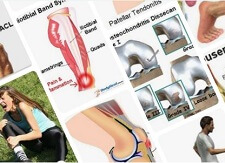- Home
- Knee Pain Diagnosis
- Swollen Knee
- Side Knee Swelling
Swelling On Side Of Knee
Written By: Chloe Wilson, BSc(Hons) Physiotherapy
Reviewed by: KPE Medical Review Board
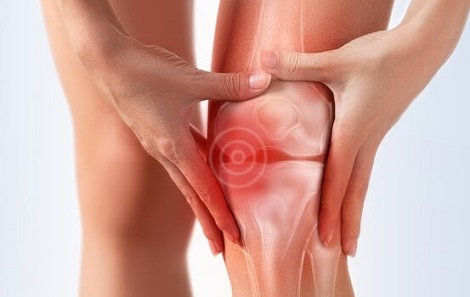
Swelling on the side of the knee is a common problem which may or may not be painful.
There are lots of different things that can cause lumps and swelling on the side of the knee but in most cases it’s nothing serious.
Side knee swelling usually means there is some kind of inflammation, tear, or damage in the ligaments or cartilage that hold your knee together but may also indicate an underlying medical issue.
There may be swelling on the inside of the knee or the outside of the knee, a hard lump on the side of the knee or generalised swelling around the joint.
It is very uncommon for a knee lump to be cancerous but any new growth should be evaluated by your doctor.
Here we will look at the common causes of swelling on the side of the knee and how to identify which one you have. We will then look at the best ways to treat side knee swelling. If you are more bothered by pain than swelling, check out the Inner Knee Pain or Outer Knee Pain articles.
What Causes Side Knee Swelling?
The most common causes of swelling on the side of the knee are:
- Meniscus Tear: damage to the cartilage lining the knee joint
- Ligament Sprain: tear in one of the collateral ligaments at the side of the knee
- Knee Arthritis: degenerative wear and tear in the knee
- Knee Bursitis: inflammation of one of the knee bursa
- ITB Syndrome: inflammation of the iliotibial band
- Plica Syndrome: inflammation of the lining of the knee joint
Each of these causes of swelling on the side of the knee will present slightly differently and require different treatment. So let’s start by looking at the common causes of side knee swelling and then we’ll have a look at the more unusual ones.
1. Cartilage Tear
The most common cause of swelling on the side of the knee is a cartilage tear aka torn meniscus.
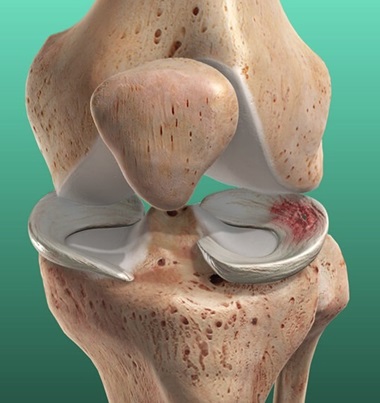
The knee has a very thick layer of cartilage known as the meniscus that helps to protect the joint.
The knee meniscus is a flexible, rubbery pad that sits between your thighbone and shinbone.
It cushions the knee and helps to improve stability and movement of the joint, acting like a shield to keep the bones from grinding against each other when you move your leg.
Cartilage tears are a common cause of swelling on the side of the knee and may be caused by:
- An Injury: sudden overloading or pinching of the meniscus e.g. sporting tackles where the knee twists awkwardly, particularly when wearing cleats
- Wear & Tear: repetitive force or friction through the knee can slowly wear away the meniscus resulting in cartilage tears. This is particularly common over the age of 60 as the meniscus becomes more brittle with age. Everyday use of the knee can cause the meniscus to fray or tear.
Cartilage tears can cause bleeding and a build-up of excess synovial fluid in the joint. This fluid puts extra pressure on the area around the tear, leading to swelling and discomfort.
The location of the swelling will depend on which part of the meniscus is torn:
- Medial Meniscus Tear: causes swelling on inside of knee (most common)
- Lateral Meniscus Tear: causes swelling on outside of knee
Swelling on the side of the knee from a meniscus tear tends to fairly diffuse rather than a specific lump or pocket of swelling.
You can find more about how cartilage tears cause swelling on the side of the knee and how to treat them in the Meniscus Tear section.
2. Ligament Tears
Another common cause of side knee swelling is a tear in one of the collateral ligaments, aka a knee sprain.
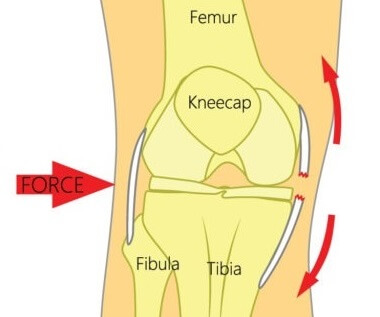
The knee collateral ligaments (MCL & LCL) are two strong bands of tissue that sit on either side of the knee joint. They help to keep the knee stable and provide support when you move your leg.
Knee collateral ligament injuries are often caused by sudden, sharp movements like twisting the knee or making a hard landing. These unexpected motions can stretch or tear the ligaments, resulting in instability and decreased range of motion.
Ligament tears can cause swelling because they disrupt the normal flow of fluid in the joint and can cause extra fluid to collect around the joint. This extra pressure can cause the area to become puffy and painful.
The location of the knee swelling will depend on which ligament is torn:
- Medial Collateral Ligament Tear: causes swelling on the inside of the knee
- Lateral Collateral Ligament Tear: causes swelling on the outside of the knee
With ligament tears, the swelling at the side of the knee tends to be fairly localised around the area where the tear is. The larger the tear, the more swelling there is likely to be.
You can find out more about the cause of swelling on the side of the knee from ligament tears and how to treat them in the Knee Ligament Injury section.
3. Knee Arthritis
The most common cause of swelling on the side of the knee in people over 65 is knee osteoarthritis.
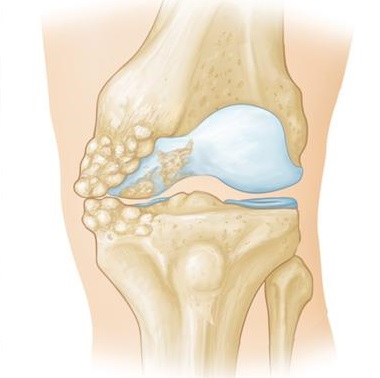
Osteoarthritis is a degenerative joint disease that causes damage and wear to the cartilage and tissue surrounding the knee bones.
This damage leads to knee pain and swelling, as well as joint stiffness, which can make it difficult to bend or straighten the knee.
As knee arthritis progresses, the joint space, the normal gap between the bones, gradually narrows and bone spurs form. Over time, the bones may start grinding against each other, causing increased friction, damage and irritation.
Swelling is a common feature of osteoarthritis for two reasons. Firstly, the tissues lining the joint become inflamed and secondly, excess synovial fluid is produced as the joint tries to protect and heal itself.
In some cases, knee osteoarthritis is confined to one side of the joint and therefore there may only be swelling on that side of the knee, most typically the inner side. Other times, the arthritis extends throughout the joint leading to more diffuse swelling.
You can find out loads more about causes, symptoms, diagnosis and best treatment options in the knee arthritis section.
4. Knee Bursitis
If you have a small pocket of swelling on the side of the knee, it may be due to knee bursitis.
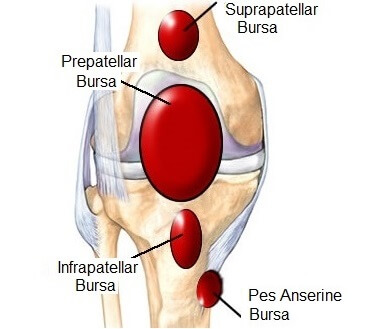
Bursa are small fluid-filled sacs that sit between bones and soft tissues to allow smooth, friction-free movement.
If one of the knee bursa gets inflamed, it can cause a localised pocket of swelling on the side of the knee.
Bursitis may be caused by repetitive or excess force through the bursa e.g. prolonged kneeling, compression from muscle tightness, injury or arthritis.
Bursitis usually causes a defined, balloon-like pocket of swelling that can vary greatly in size, and may resemble anything from a small grape to a squashy orange.
There are a number of different bursa around the knee which can cause swelling in different places:
- Pes Anserine Bursitis: swelling on inside of knee, 2-3cm below the joint
- Iliotibial Bursitis: swelling on the outside of the knee, just below the joint
- Semimembranosus Bursitis: swelling behind the knee
- Prepatellar Bursitis: swelling in front of knee
- Infrapatellar Bursitis: swelling below knee
- Suprapatellar Bursitis: swelling above knee
You can find out all about the different types of bursitis, how they cause knee swelling and how to treat them in the Knee Bursitis section.
5. ITB Syndrome
If you have swelling on the outside of your knee, it may be due to Iliotibial Band Syndrome, particularly if you are a long-distance runner.
The ITB is a thick band of tissue that runs down the outer thigh between the hip and knee.
Repetitive friction through the ITB, where it attaches to the outer side of the knee, leads to irritation and inflammation which can cause localised swelling on the outside of the knee.
ITB syndrome is often caused by long distance running, suddenly increasing your training program, muscle imbalance or altered foot biomechanics.
If you think this may be the cause of the swelling on the outside of your knee, check out the ITB Syndrome section for more information on causes, symptoms, treatment options and prevention.
6. Plica Syndrome
Another possible cause of a lump on the side of the knee is plica syndrome.
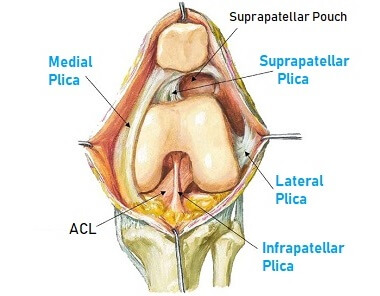
Knee plica are small folds in the synovial membrane, the thin sheet of tissue that lines and surrounds the knee joint, providing lubrication and protection.
In plica syndrome, these folds become inflamed, due to irritation from repetitive friction, a knee injury or underlying knee condition.
Plica syndrome typically causes a dull, aching pain in the knee which is often worse at night or when bending and straightening the knee e.g. stairs or squats. There is often a clicking or popping sound as you move the knee.
There may be localised knee swelling over the inflamed area, which may not be obviously visible, but when you press over the area it may feel “boggy”. The area of knee swelling will depend on which part of the plica is inflamed:
- Medial Plica Syndrome: swelling on inside of knee. Most common place to develop plica syndrome
- Lateral Plica Syndrome: swelling on outside of knee. Least common site for plica syndrome
- Suprapatellar Plica Syndrome: lump above knee
- Infrapatellar Plica Syndrome: lump under knee
You can find out lots more about the causes, symptoms, diagnosis and treatment options in the Knee Plica Syndrome section.
Rare Causes Of Side Knee Swelling
There are a few other causes of swelling on the side of the knee which are rare but potentially serious:
- Synovial Sarcoma: a malignant growth most common in young adults. A sarcoma lump on side of knee tends to gradually increase in size to larger than 5 cm and is often painful.
- DVT: a blood clot in one of the deep veins in the leg. With a DVT there may be swelling behind or at the side of the knee or in the calf. The area is usually red, warm to touch and accompanied by a throbbing pain.
- Knee Dislocation: where the bones shift out of alignment, usually from an injury. The most common knee dislocations to cause obvious deformity and swelling at the side of the knee are kneecap dislocations and proximal tibiofemoral joint dislocations.
While these are rare causes of swelling at the side of the knee, they are all extremely serious and require immediate medical attention.
How To Treat Side Knee Swelling
Treatment for swelling on the side of the knee will depend on the underlying cause but may include a combination of:
1. Ice Treatment
Regularly applying an ice pack to the area of side knee swelling helps to reduce swelling by constricting the blood vessels surrounding the injured area. This constriction reduces blood flow and decreases inflammation, which helps reduce knee swelling.
Ice treatment is most effective when applied for periods of 15-20 minutes, multiple times throughout the day. Find out more about the best ways to apply ice.
2. Compression Bandage
Tubigrip is a specially designed elasticated bandage that provides gentle compression around the knee. It helps reduce inflammation and limits fluid build-up which stops fluid from pooling both in and around the knee.
It is important to use the correct size and tension Tubigrip for effective results, and to frequently check the affected area to ensure it's not becoming too tight as swelling the side of the knee often fluctuates.
3. Elevation
Raising your knee, ideally above the level of your heart, will help to reduce swelling on the side of the knee.
Elevating your knee helps reduce swelling by enabling the lymphatic vessels to drain away the excess fluid accumulated in the area. When sitting or lying down, either prop your leg up on some pillows, or even better get a leg elevation cushion which not only elevates the knee, but also supports it in a good position.
4. Aspiration
Aspiration is a procedure where a needle is used to withdraw excess fluid from the knee joint. This helps reduce swelling as it removes the build-up of fluid in the area, while also providing relief from pain and discomfort.
5. Medication
There are various medications that can help to reduce side of knee swelling. Often, over-the-counter medications are sufficient but if there is extensive swelling, talk to your doctor or pharmacist about what medications would be best for you.
You can find out loads more about how to reduce side knee swelling and get the best results in the swollen knee treatment section.
Swelling On Side Of Knee Summary
There are lots of possible causes of side of knee swelling.
Generalised swelling on inside of knee may be due to a medial meniscus tear, knee arthritis or a moderate to severe MCL tear.
A more defined lump on the inside of the knee may be caused by an MCL sprain, pes anserine bursitis, knee bone spurs or medial plica syndrome.
Generalised swelling on outside of knee may be due to a lateral meniscus tear, knee arthritis or a moderate to severe LCL tear.
A more defined lump on the outside of the knee may be caused by an LCL sprain, ITB syndrome, bone spurs or lateral plica syndrome.
Occasionally, swelling on the side of the knee may indicate a serious problem such as cancer or a blood clot so any new incidence of side knee swelling should be reviewed by your doctor as soon as possible, particularly if accompanied by symptoms such as unexplained weight loss or breathing difficulties.
Treatment for swelling on side of knee will depend on the underlying cause but may include a combination of RICE (rest, ice, compression & elevation), aspiration and medication – find out more in the swollen knee treatment section.
You may also be interested in the following articles:
- Swelling Behind The Knee
- Swelling Above Knee
- Swelling Below The Knee
- Front Knee Swelling
- Inner Knee Pain
- Outer Knee Pain
- Knee Pain Diagnosis Charts
Related Articles
Common Knee Problems
October 2, 2023
Knee Pain Diagnosis
March 27, 2025
Knee Strengthening
January 14, 2023
References
- The Acute Swollen Knee: Diagnosis & Management. Journal of The Royal Society Of Medicine
- Generalised Knee Swelling In Adults. Singapore Medical Journal
Page Last Updated: 21/08/24
Next Review Due: 21/08/26

